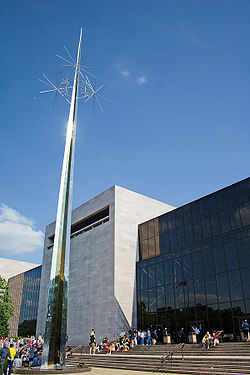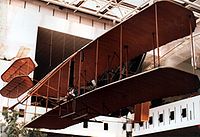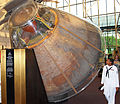- National Air and Space Museum
-
Not to be confused with Steven F. Udvar-Hazy Center.
Coordinates: 38°53′18″N 77°01′12″W / 38.888333°N 77.02°W
National Air and Space Museum 
Established Built in 1976 Location Washington, D.C. Visitor figures 6,012,229 (2007)
200+ million cumulative (2007)[1]Director Gen. John R. Dailey Curator Tom Crouch Public transit access L'Enfant Plaza (Washington Metro) and L'Enfant Plaza (VRE station) Website http://www.nasm.si.edu The National Air and Space Museum (NASM) of the Smithsonian Institution holds the largest collection of historic aircraft and spacecraft in the world.[2] It was established in 1976. Located in Washington, D.C., United States, it is a center for research into the history and science of aviation and spaceflight, as well as planetary science and terrestrial geology and geophysics.[2] Almost all space and aircraft on display are originals or backups to the originals. It is the second-most popular[3] of the Smithsonian museums and operates an annex, the Steven F. Udvar-Hazy Center, at Dulles International Airport. The museum currently conducts restoration of its collection at the Paul E. Garber Preservation, Restoration, and Storage Facility in Suitland, Maryland.
Contents
Architecture
Because of the museum's close proximity to the United States Capitol, the Smithsonian wanted a building that would be architecturally impressive but would not stand out too boldly against the Capitol building. St. Louis-based architect Gyo Obata of Hellmuth, Obata and Kassabaum accepted the challenge and designed the museum as four simple marble-encased cubes containing the smaller and more theatrical exhibits, connected by three spacious steel-and-glass atria which house the larger exhibits such as missiles, airplanes and spacecraft. The mass of the museum echoes the National Gallery of Art across the National Mall, and uses the same pink Tennessee marble as the National Gallery.[4] Built by Gilbane Building Company, the museum was completed in 1976. The west glass wall of the building is used for the installation of airplanes, functioning as a giant door.[5]
History
 Wright Flyer hanging in the museum in 1982
Wright Flyer hanging in the museum in 1982
The museum was originally called the National Air Museum when formed on August 12, 1946 by an act of Congress and signed into law by President Harry S. Truman,[6][7] some pieces in the National Air and Space Museum collection date back to the 1876 Centennial Exposition in Philadelphia after which the Chinese Imperial Commission donated a group of kites to the Smithsonian after Smithsonian Secretary Spencer Fullerton Baird convinced exhibiters that shipping them home would be too costly. The Stringfellow steam engine intended for aircraft was accessioned into the collection in 1889, the first piece actively acquired by the Smithsonian now in the current NASM collection.[8]
After the establishment of the museum, there was no one building that could hold all the items to be displayed, many obtained from the United States Army and United States Navy collections of domestic and captured aircraft from World War I. Some pieces were on display in the Arts and Industries Building, some were stored in the Aircraft Building (also known as the "Tin Shed", a large temporary metal shed in the Smithsonian Castle's south yard. Larger missiles and rockets were displayed outdoors in what was known as Rocket Row. The shed housed at large Martin bomber, a LePere fighter-bomber, and an Aeromarine 39B floatplane. Still, much of the collection remained in storage due to a lack of display space.[8]
The combination of the large numbers of aircraft donated to the Smithsonian after World War II and the need for hangar and factory space for the Korean War drove the Smithsonian to look for its own facility to store and restore aircraft. The current Garber Facility was ceded to the Smithsonian by the Maryland-National Capital Park and Planning Commission in 1952 after the curator Paul E. Garber spotted the wooded area from the air. Bulldozers from Fort Belvoir and prefabricated buildings from the United States Navy kept the initial costs low.
The space race in the 1950s and 1960s led to the renaming of the museum to the National Air and Space Museum, and finally congressional passage of appropriations for the construction of the new exhibition hall[citation needed], which opened July 1, 1976 at the height of the United States Bicentennial festivities under the leadership of Director Michael Collins, who had flown to the Moon on Apollo 11. The Steven F. Udvar-Hazy Center opened in 2003, funded by a private donation.
The museum will receive several artifacts, including a former camera, that were removed from the Hubble Space Telescope and returned to Earth after Space Shuttle mission STS-125. The museum also holds the backup mirror for the Hubble which, unlike the one that was launched, was ground to the correct shape. There were once plans for it to be installed to the Hubble itself, but plans to return it to Earth were scrapped after the Space Shuttle Columbia disaster in 2003; the mission was re-considered as too risky.
The Smithsonian has also been promised the International Cometary Explorer, which is currently in a solar orbit that occasionally brings it back to Earth, should NASA attempt to recover it.
Controversies
Controversy erupted in March 1994 over a proposed commemoration of the 50th anniversary of the atomic bombing of Japan. The centerpiece of the exhibit was the Enola Gay, the B-29 bomber that dropped the A-bomb on the Japanese city of Hiroshima. Veterans' groups, led by the Air Force Association and The Retired Officers Association, argued strongly that the exhibit's inclusion of Japanese accounts and photographs of victims politicized the exhibit and insulted U.S. airmen.[9] Also disputed was the predicted number of U.S. casualties that would have resulted from an invasion of Japan, had that been necessary, after the museum director, Martin O. Harwit, unilaterally reduced the figure by 75% on January 9, 1995, at the height of the dispute. On January 18 the American Legion called for a congressional investigation of the matter, and on January 24, 1995, 81 members of Congress called for Harwit's resignation. Harwit was forced to resign on May 2. Although the exhibit was "radically reduced" and criticized by the New York Times as "the most diminished display in Smithsonian history," [10] the Air and Space Museum placed the forward fuselage of the Enola Gay and other items on display as part of a non-political historical exhibition. Within a year, it had drawn more than a million visitors, making it the most popular special exhibition in the history of the NASM, and when the exhibition closed in May 1998, it had drawn nearly four million visitors.[11]
On October 8, 2011, the museum was temporarily closed after demonstrators associated with the Occupy D.C. demonstration attempted to enter the museum. Some protesters were peppered sprayed by museum security after a guard was pinned against a wall. One woman was arrested.[12][13][14][15]
Directors
Carl W. Mitman was the first head of the museum, under the title of Assistant to the Secretary for the National Air Museum, heading the museum from 1946 until his retirement from the Smithsonian in 1952.[16]
The following have been, or acted as, director of the museum:
- Philip S. Hopkins, 1958-1964[16]
- S. Paul Johnston, 1964-1969[16]
- Frank A. Taylor (acting), 1969-1971[16]
- Michael Collins, 1971–1978;[17]
- Melvin B. Zisfein (acting), 1978-1979[17]
- Noel W. Hinners, 1979-1982[17]
- Walter J. Boyne (acting 1982–1983, director 1983-1986)[17]
- James C. Tyler (acting), 1986-1987[17]
- Martin O. Harwit, 1987-1995[17]
- Donald D. Engen, 1996-1999[18]
- John R. Dailey, 2000–present[18]
Gallery of exhibits
Main article: List of aircraft in the Smithsonian Institution-
Ad Astra ("to the stars"), the sculpture at the entrance to the building
-
Mercury Friendship 7 spacecraft
-
Apollo 11 Command Module
-
The space suit worn by David Scott on Apollo 15
-
Apollo Lunar Module LM-2
-
Original Star Trek production model of the USS Enterprise
See also
- Continuum a sculpture that sits on the south side of the building entrance.
- Delta Solar a sculpture that sits on the west side of the building.
- Charles A. Lindbergh Chair in Aerospace History; NASM-sponsored senior scholarship
References
- ^ "Building on the National Mall Fact Sheet". National Air and Space Museum. The Smithsonian Institution. http://www.nasm.si.edu/events/pressroom/presskits/museumkit/facts_mall.cfm. Retrieved November 3, 2010.
- ^ a b "Overview". National Air and Space Museum. The Smithsonian Instituion. http://www.nasm.si.edu/museum/. Retrieved November 3, 2010.
- ^ Trescott, Jacqueline (March 9, 2010). "One hundred years later, evolution continues for Smithsonian's Natural History museum". The Washington Post. http://www.washingtonpost.com/wp-dyn/content/article/2010/03/08/AR2010030804014.html. Retrieved November 3, 2010.
- ^ Scott, Pamela; Lee, Antoinette J. (1993). "The Mall". Buildings of the District of Columbia. New York: Oxford University Press. p. 91. ISBN 0-19-509389-5.
- ^ A Guide to Smithsonian Architecture. Smithsonian Institution. 2005 [2006]. pp. 15.
- ^ "National Air and Space Museum Chronology". National Air and Space Museum. The Smithsonian Instituion. http://www.nasm.si.edu/museum/history/nasm25th/chronology/index.htm. Retrieved November 3, 2010.
- ^ "History of the National Air and Space Museum". National Air and Space Museum. The Smithsonian Institution. http://www.nasm.si.edu/museum/history.cfm. Retrieved November 3, 2010.
- ^ a b "From Kites to the Space Shuttle, A History of the National Air and Space Museum". Air and Space. January 2011.
- ^ Los Angeles Times, May 3rd, 1995, p. 21
- ^ New York Times, Aug. 6th, 1995 http://query.nytimes.com/gst/fullpage.html?res=990CE4D61238F935A3575BC0A963958260
- ^ "Chronology of the Controversy". Enola Gay Archive. Air Force Magazine.com. http://www.airforce-magazine.com/MagazineArchive/EnolaGayArchive/Pages/ChronologyoftheControversy.aspx. Retrieved 2011-09-01.
- ^ http://www.usatoday.com/news/washington/story/2011-10-08/wall-street-protest/50704774/1?csp=34news
- ^ http://articles.cnn.com/2011-10-08/politics/politics_dc-protest-museum_1_pepper-spray-protesters-space-museum?_s=PM:POLITICS
- ^ http://www.msnbc.msn.com/id/44829459/ns/us_news-life/t/washingtons-air-space-museum-shut-after-protesters-storm/
- ^ http://www.washingtonpost.com/blogs/post_now/post/air-and-space-museum-closes-after-guards-clash-with-protesters/2011/10/08/gIQAx0x2VL_blog.html
- ^ a b c d Finding Aids to Official Records of the Smithsonian Institution, Record Unit 330: Series 1, National Air and Space Museum, Records, 1912-1971
- ^ a b c d e f Finding Aids to Official Records of the Smithsonian Institution, Record Unit 338, National Air and Space Museum, Records, circa 1972-1989
- ^ a b National Air and Space Museum, Office of the Director - Agency History
External links
- Official website
- Photos and QTVR Virtual Tours
- Image Gallery
- American Institute of Architects on the building
- rocket displays outside Arts and Industries building prior to construction of Air and Space Museum
- 'Star Wars: The Magic of Myth, virtual walk through of the past NASM exhibit
- Teachinghistory.org review of NASM website Black Wings
Lists relating to aviation General Aircraft (manufacturers) · Aircraft engines (manufacturers) · Airlines (defunct) · Airports · Civil authorities · Museums · Registration prefixes · Rotorcraft (manufacturers) · TimelineMilitary Accidents/incidents Records Categories:- Buildings and structures completed in 1976
- Aviation history of the United States
- National Mall
- IMAX venues
- Planetaria in the United States
- Aerospace museums
- Aerospace museums in Washington, D.C.
- Science museums in Washington, D.C.
- Members of the Cultural Alliance of Greater Washington
- American national museums in Washington, D.C.
- Smithsonian Institution museums
Wikimedia Foundation. 2010.

















